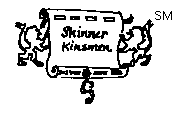

- Volume 2 Number 3
- Summer 1985
- Letter From the Editor
- Albert C Skinner Obituary
- Debrett Ancestry Search
- Ethnic Skinners
- Gasoline Alley
- Dolorose Skinner Legutki Celebration
- miscSKINNERlaneous
- NY, Sherburne
- Summer 1985
- Christ's Church Cemetery
- PA, Mill Run
- Skinner Family
- Queries
- Resurgence
- S.A.L.E.
- Resurgence
- Skinner Allied Lines Exchange
- Scot's Skinner Reminisces
- Skinner - Davis Scrapbook
- Skinner Kinsmen Letter
- Skinner Name of
- Skinner - Davis Scrapbook
- Scottish Origin
- Skinner Settlement
- John Skinner's Will
- Truck Driving Granny
- John Skinner's Will
Thanks to William Weiler for transcription of this article.
contributed by
Frances Gorton Skinner Barnard McKay, MI
( Estelle Heath Skinner (9), Charles Otis (8), Elias (7), Benjamin (6,5,4), Thomas (3,2), Thomas of Malden (1) )
Most Scot names weren't assumed until after the 11th century, and the larger proportion of them came into being since the 13th century.
In Scotland, whoever joined a clan took the surname of its Chief to show loyalty to this leader. Thus, those who bear the same appellation aren't necessarily descended from a common ancestor.
Originally, ALL Scottish surnames had a meaning, but corruptions in spelling were many, and the orthography of them has only been fixed during the last 2 centuries. Thus, the true meaning may have been lost.
The original form of Skinner appears to have been SKENE. Even today it has many variations (SKINER, SKYNER, SKYNE, etc.).
A skene was a dirk or a knife (used in slaying as well as skinning animals). The Scottish Dirk, worn in the clansman's stocking when English law forbade him to carry a sword and later kept in his Scottish regalia, was the 'Skene-dhu' or black dirk.
The story goes that Struan Robertson rode with the King in Stocket Forest in Athole, Scotland. Apparently they were attacked or feared they would be attacked by a wolf, and drawing his dirk, Robertson killed the beast in the King's presence.
For this deed, he received the name of Skene, which signified his dirk, and was given a coat of arms bearing 3 dirks with points in pale.
- This information was published by J. Munsell of New York in "Origin and Signification of Scottish Names," dated: 1862, as well as in other name sources.